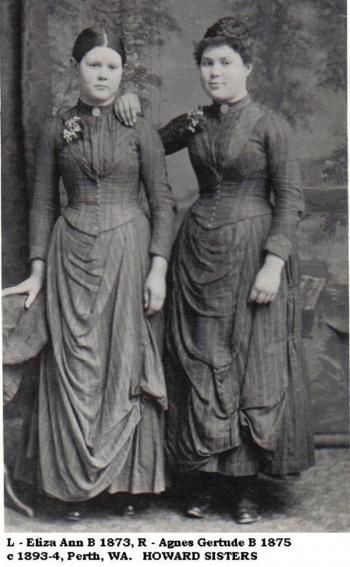Agnes Gertrude Howard

Family Story
Agnes Gertrude Howard
Written by Christine Spence
Agnes Gertrude Howard, born on 30 September 1875 in Litlington, Cambridgeshire, England, sadly died on the 2 February 1895 in Cottesloe, Western Australia. A note left for her sister Eliza Ann Howard read: “Dear Sister – Goodbye. I am going to commit suicide, as I cannot live any longer because I am so miserable”. Agnes, Eliza’s beautiful younger and only surviving sister – dead by her own hand, barely 18 months after their arrival in Fremantle.
Eliza Ann Howard was called to be a witness at the inquest into her sister’s sudden death. Eliza described to the coroner how she and Agnes, both domestic servants in England, had immigrated to Western Australia. They sailed on the SS Port Phillip, arriving in September 1893. Both had subsequently found employment, firstly with Mrs Craig of York. The sisters later moved to other domestic positions in the Perth area and corresponded with each other by letter. Eliza told the coroner she knew Agnes was unhappy. Before leaving England Agnes had a broken engagement, and had threatened to take her own life twice since. Eliza had recently found a new position for Agnes as a children’s nurse in the hope this would help her settle in her adopted country.
Sadly, Agnes succumbed to her depression in a most tragic way. Leaving her final, sad note for her sister, Agnes threw herself down a 53 foot well at her employer’s home in Cottesloe and was not discovered until the following morning.
“Inquest, Perth: On the 6th inst, at the Police Court before James Cowan, Esq., P.M. and Coroner on the body of Agnes Gertrude Howard, found dead in a well at Claremont on the 3rd inst. Verdict – Suicide while suffering temporary insanity”. Coldly reported thusly in the Police Gazette of 6 February 1895, the national Australian newspapers widely reported the tragedy more fully, describing Agnes as “suffering from melancholia”.
Agnes was buried in the East Perth Cemetery, in an unmarked grave. Eliza, supporting herself on the wages of a domestic servant of one pound ten shillings a month, probably could not afford a headstone for her sister.
How did this grim story unfold? The Howard family lived in the small Cambridgeshire village of Litlington, where Joseph worked as an agricultural labourer. Mary Sell had been a straw plaiter (sic) before falling pregnant and marrying Joseph in 1860 at St Catharine’s Church, Litlington. Ten children – seven daughters and three sons - were born to Joseph and Mary between 1860 and 1879, and were baptised in the same church. Eliza, born in 1873, was to be the only daughter to survive into adulthood.
The miserable tale began when Mary and Joseph’s fourth daughter Martha died aged only 18 months in 1870. Seven years later tuberculosis took the life of their firstborn child Harriet, who died aged 17 of abdominal tuberculosis. Tragically, two years later in 1879 Joseph was widowed when his beloved Mary, aged just 39, died of bronchitis. Compounding this loss, Mary’s death occurred only two weeks after giving birth to their tenth child Lydia, leaving Joseph a widower with a newborn baby and seven older children to care for.
Joseph was described in the 1881 census as a widower, with no listed occupation. He had seven children at home in Royston Road, Litlington – one son worked at a nearby village as a labourer. Tragedy was to strike the family again in 1882, when sisters Ada aged 14 and Mary Ann aged 17 died of tuberculosis, seven months apart. Three months after Mary Ann’s death this terrible disease was to also claim the life of three-year-old Lydia in January 1883. Family stories say that Eliza and Agnes were encouraged to leave Litlington and England for their health, to escape from the scourge of tuberculosis.
Eliza aged 20 and Agnes aged 18 took advantage of a scheme run by the United British Women's Emigration Association that encouraged young women of good character to immigrate to the Colonies. Eliza and Agnes chose Australia – perhaps because their brother Joseph had already immigrated to Bundaberg, Queensland in 1888. It is easy to imagine they did not realise the vast size and distances of Australia, nor that their brother would be on the other side of the continent to Western Australia.
Eliza survived the devastating illnesses and sadness that befell her family. She married Francis Paull, a carrier, in Perth in 1896. Together they set up a farm in West Coolup near Pinjarra. Eliza and Francis had seven children, six of whom survived to adulthood. Their first daughter was named “Agnes Mary” in memory of Eliza’s beloved sister and mother. After such a sad start to her life, Eliza went on to live a long and full life. She died in Waroona in 1969 aged 96.



